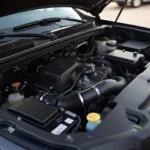OBD2 communication is the language your car uses to speak to diagnostic tools and, ultimately, to you. This system, mandatory in vehicles manufactured since 1996, allows you to tap into your car’s inner workings and understand its health and performance. But what exactly is OBD2 communication, and how does it work?
Decoding the Language of Your Car: OBD2 Protocols Explained
At the heart of OBD2 communication lie standardized protocols, the rules governing how information is exchanged between your car’s onboard computer and an OBD2 scanner. These protocols ensure that regardless of your car’s make or model, the diagnostic process remains consistent.
Think of these protocols like different dialects. Your car might “speak” a specific one, such as:
- SAE J1850 PWM: Commonly found in Ford vehicles.
- SAE J1850 VPW: Utilized by General Motors.
- ISO 9141-2: Often found in European and Asian vehicles.
- ISO 14230-4 (KWP2000): A newer protocol gaining popularity.
- ISO 15765-4 (CAN): The most recent standard, quickly becoming the industry norm.
Understanding the specific protocol your car uses can be helpful when choosing an OBD2 scanner, as some scanners might be compatible with certain protocols but not others.
The Nuts and Bolts: How OBD2 Communication Works
OBD2 communication relies on a dedicated connector, typically located under the driver’s side dashboard. This connector, standardized in shape and pin configuration, serves as the gateway for data transfer.
When you plug an OBD2 scanner into the connector, it establishes a connection with your car’s Electronic Control Unit (ECU), the brain behind your vehicle’s various systems. The scanner then initiates communication using the appropriate protocol, sending requests for specific data points.
Your car’s ECU responds to these requests by transmitting data back to the scanner. This data, often presented in the form of Diagnostic Trouble Codes (DTCs), provides valuable insights into your car’s health, including:
- Engine performance
- Emissions levels
- Transmission status
- Airbag system functionality
- Anti-lock Brake System (ABS) status
 OBD2 Scanner Connecting to Car's System
OBD2 Scanner Connecting to Car's System
“The ability to access this data through OBD2 communication empowers car owners to troubleshoot issues, monitor performance, and potentially even save on costly repairs,” says Emily Carter, Senior Automotive Engineer at OBDFree. “It’s like having a direct line to your car’s doctor.”
Beyond Diagnostics: The Expanding Role of OBD2 Communication
While OBD2 communication was initially designed for emissions testing and diagnostics, its applications are expanding rapidly. Today, this technology plays a crucial role in:
- Vehicle Tracking and Fleet Management: Real-time data on location, speed, and fuel consumption enhances fleet efficiency and security.
- Insurance Telematics: Driving behavior monitoring allows insurers to offer personalized premiums based on individual driving habits.
- Performance Tuning: Enthusiasts can access and modify engine parameters to optimize their car’s performance.
- Predictive Maintenance: By analyzing data trends, potential issues can be identified before they escalate into major problems.
FAQs: Common Questions About OBD2 Communication
1. Can any OBD2 scanner communicate with my car?
While most scanners support common protocols, compatibility depends on your car’s make, model, and year. It’s essential to choose a scanner that supports your vehicle’s specific protocol.
2. What is the difference between OBD1 and OBD2?
OBD2, introduced in 1996, offers standardized protocols and a universal connector, making it more comprehensive and user-friendly than its predecessor, OBD1.
3. Is it safe to use an OBD2 scanner on my car?
Yes, using a reputable OBD2 scanner is generally safe. However, it’s crucial to avoid modifying any settings or parameters unless you have a thorough understanding of their implications.
4. Where can I find more information about my car’s specific OBD2 communication protocol?
Your car’s owner’s manual or a trusted online resource like OBDFree can provide details about your vehicle’s protocol and other relevant information.
5. Can I use OBD2 communication for DIY repairs?
While OBD2 communication can assist in identifying issues, performing repairs often requires specialized knowledge and tools. Consult a qualified mechanic for complex repairs.
Need More Information or Assistance?
For further insights into OBD2 communication, specific vehicle applications, or to explore a wide range of OBD2 scanners, visit OBDFree or other relevant articles on our site, such as:
- Ford Transit Connect OBD2 Location
- 95 EG Convert to OBD2
- OBD2 H22
- Is a 93 Bronco OBD1 or OBD2
- Honda OBD1 to OBD2 Alternator Conversion
Our team is available 24/7 to answer your questions and provide expert guidance. Contact us via WhatsApp at +1(641)206-8880 or email us at [email protected]. Let us help you unlock the secrets of your car’s communication system.
